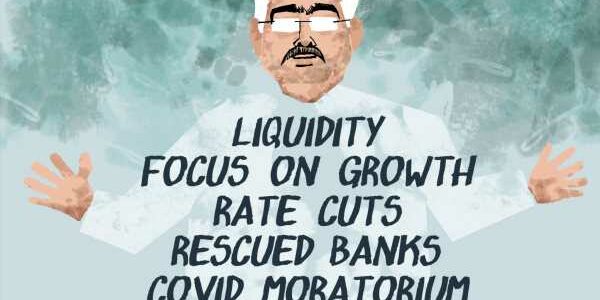
‘RBI faces an uphill task this year’
‘It is going to be a tough balance for the RBI to manage economic stability and ensure smooth government borrowing.’
With the rise in commodities prices and domestic growth picking up, inflation needs to be watched closely, warns Arun Srinivasan, senior executive vice president and head of fixed income, ICICI Prudential Life Insurance.
“While the RBI has dismissed the recent readings of consumer price index as being transitory and supply driven, in our opinion, it’s a matter of time before inflation becomes demand driven,” Srinivasan tells Ashley Coutinho.
What do you make of the recent RBI policy review?
While the RBI kept rates unchanged, this policy was important as it took steps towards rate normalisation.
Upscaling of VRR (voluntary retention route) amount by Rs 2 trillion shows the RBI has started with the gradual withdrawal of surplus liquidity.
This policy was definitely less dovish than previous ones.
With growth showing green shoots and vaccination picking up, it is a matter of time before the RBI further increases the VRR amount along with tenure.
We expect the rate corridor to compress by the end of this calendar year.
What is your view on trajectory of interest rates?
We expect a gradual grind upwards in bond yields.
While yields have risen after the policy, further correction of 10-15 basis points can occur.
The RBI cannot shy away from the fact that the supply this year from the Centre and states is huge and, therefore, there is only limited ammunition available.
We expect the 10-year G-sec benchmark to inch closer to 6.40-6.45 per cent levels by the end of the calendar year.
What about inflation?
While the RBI has dismissed the recent readings of consumer price index (CPI) as being transitory and supply driven, in our opinion, it’s a matter of time before inflation becomes demand driven.
With the rise in commodity prices and domestic growth picking up, inflation requires a close watch.
The base effect will be favourable over the next six months, but one needs to watch for month-on-month upticks, especially core inflation.
How do you perceive the borrowing programme for FY22?
The RBI faces an uphill task this year. There are multiple factors at play and uncertainties that can really swing the Budget projections.
The pandemic will require continuous government borrowing not just this year, but for the next couple of years.
It is going to be a tough balance for the RBI to manage economic stability and ensure smooth government borrowing.
What is your outlook on debt and yield curve?
The current yield curve is one of the steepest we have seen.
While the shorter end rates have been well anchored owing to liquidity, the longer end remains under pressure.
We expect interest rates to maintain an upward bias till the end of this financial year.
In our view, the one to five-year segment of the curve will bear the brunt first when the RBI accelerates rate normalisation. In short, we expect a bear flattening scenario.
What are the potential hurdles for India’s inclusion in bond index?
India’s inclusion in the global bond indices will go a long way in getting a new set of investors in the market.
This is needed because for a long time, our bond market has been dependent on banks, provident and pension funds and insurance companies for absorbing the supply.
However, there are few operational factors that are acting as deterrents for getting India included like a cap on the quantum of investments international investors can make in these funds.
Since India does not offer full capital account convertibility on the currency, investors rank GoI as having limited liquidity.
Tax issues also need addressing with foreign investors demanding the Indian bonds be made part of international central securities depositories such as Clearstream.
We believe the efforts of the RBI’s and government are on the right track and expect traction hopefully by the end of this financial year.
The anticipation of earlier tapering of bond buying by the US Federal Reserve has pushed 10-year treasury yields to their longest rising run in 6 months. What impact will this have on India?
Our markets have become more and more intertwined with global ones.
Moreover, the RBI looks for cues from global central bankers, whether it is for rate actions or any unconventional measures and has always taken a leaf out of global central bankers’ books.
So definitely, US Fed taper will have a bearing on Indian bond yields.
This can further add on to the upward pressure on yields domestically.
Feature Presentation: Rajesh Alva/Rediff.com
Source: Read Full Article

